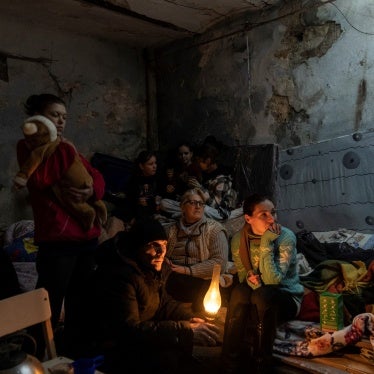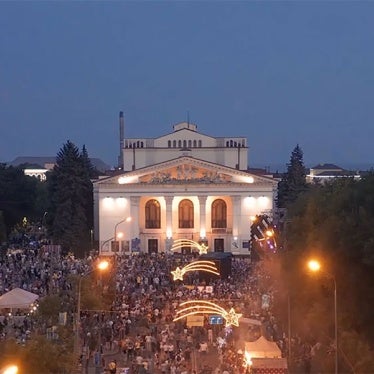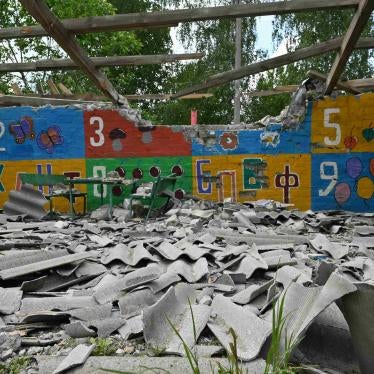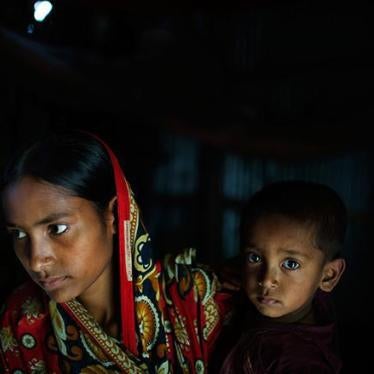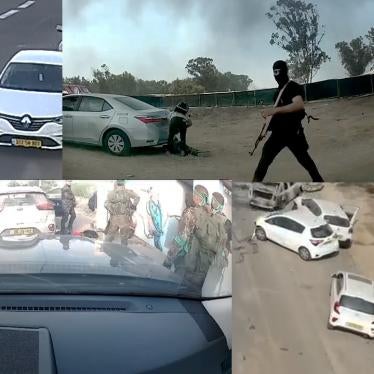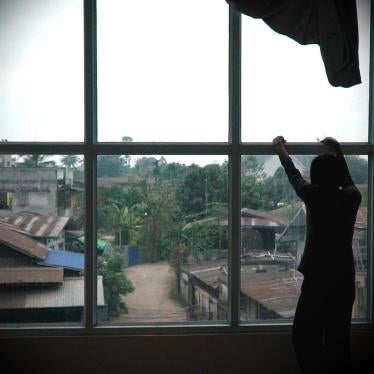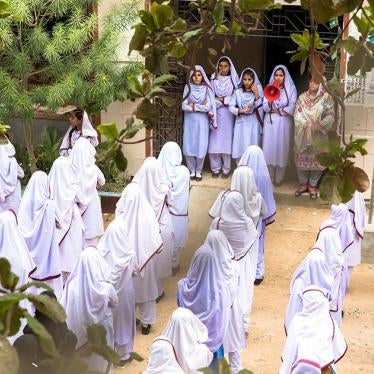- 俄罗斯2022年进攻乌克兰马里乌波尔市,导致成千上万平民死伤,最新调查显示其中包含许多疑似非法攻击行为。
- 俄罗斯军队摧毁马里乌波尔并持续致力抺杀乌克兰文化,堪称俄军全面入侵乌克兰的最丑恶篇章之一。
- 致力寻求正义的国际机构和各国政府应集中力量调查可能涉及马里乌波尔战争罪行的俄罗斯高级官员。
(基辅)-人权观察、真相追踪(Truth Hounds)和现场研究团队(SITU Research)今天发表含有广泛新发现的报告指出,俄罗斯军队于2022年2月到5月对乌克兰城市马里乌波尔(Mariupol)的进攻,包含许多疑似非法攻击行为,导致成千上万平民死伤,数十万人被围困数周且无法获得基本服务。俄罗斯总统普京和其他高级官员应当受到调查,并因其在俄军于当地作战期间犯下疑似战争罪行中的作用而受适当起诉,俄罗斯也应向违反战争法行为的受害者及其家属提供赔偿。
这份224页的报告《‘我们的城市灰飞烟灭’:俄罗斯对乌克兰马里乌波尔的毁灭攻击》,以及附带的数位多媒体专题报导和一支20分钟影片,分析了当地平民苦难和成千上万建筑物受到的毁损,包含数百栋高层公寓、医院、教育机构和水、电供应设施。同时,也说明乌克兰官员和国际机构多次尝试组织正式撤离和援助物资递送,均遭俄方阻挠。

阅读这支影片的文字描述
VAAGN MNATSAKANIAN: “In the first days of the war, we had no idea that such a tragedy could take place.”
TETIANA BURAK: “That’s why a lot of people didn’t evacuate.”
MYKHAILO PURYSHEV, MARIUPOL RESIDENT AND HUMANITARIAN VOLUNTEER: “With the onset of the war, everyone’s life changed. Everything changed.”
VOICE IN VIDEO: “Stay back!”
This is the story of Russia’s assault on Mariupol.
A strategic port city in southeastern Ukraine.
These are the interviews, videos, photos, and 3D models that Human Rights Watch, SITU Research, and Truth Hounds used to reconstruct the struggles residents faced as Russian forces took over the city.
This is Mariupol after Russian forces occupied the city. Russia’s full-scale military invasion of Ukraine began on February 24, 2022, as its forces attacked Ukrainian positions defending Mariupol.
The city was pounded by explosive weapons for weeks.
Much of Mariupol was seriously damaged in the Russian assault. Human Rights Watch and SITU Research conducted a detailed damage assessment of the destruction. While satellite imagery shows damage to rooftops, our modeling reveals more. We used over 850 videos and photos of buildings that we found online and verified, in addition to satellite imagery, to capture the extent of the devastation in the city center. Buildings with damage are seen here in red. Our analysis shows that 93% of the 477 high-rise apartment buildings in this area were damaged. Some of this imagery could help prove war crimes. Our focus was Mariupol’s main avenue, Myru or “Peace” Avenue, and the immediate surrounding area, the city center, which includes cultural hubs, hospitals, schools, and universities.
And this is Mariupol before.
DMYTRO KULYK: “It’s [was] a town with about half a million inhabitants.”
HALYNA MOROKHOVSKA: “Recently, it had blossomed. We had new parks. The city center was well-developed.”
NATALIIA TKACHENKO: “In general, the city was becoming modern and vibrant.
For Russian forces, Mariupol was a strategic prize. It would give them control of one of Ukraine’s largest ports and a land corridor between occupied Crimea to the west and areas Russia had been controlling in Donbas, to the northeast.
As the attack on the city began, tens of thousands of civilians huddled in shelters and basements to escape Russian bombing and shelling. Many people we spoke to relocated to the city center, which they believed to be safe.
DENYS SHEVTSOV: “Most people moved in all directions. To a bomb shelter, to a basement. Some stayed in their apartments. But we believe it isn’t safe to stay in the apartment... We are in the basement now. This is our makeshift bomb shelter. These are the conditions we live in. About 40 people live here with us, about 15 children.”
DENYS SHEVTSOV: “This morning, our yard was heavily shelled. Basically, all the cars were destroyed, and the windows.”
Russian forces used a variety of explosive weapons in Mariupol including aerial bombs and ground-launched artillery, such as projectiles and rockets. The use of these weapons in populated areas is the greatest threat to civilians in contemporary armed conflicts and heightens the risk of unlawfully indiscriminate attacks.
HALYNA MOROKHOVSKA: “An aerial bomb hit the dormitory. My face was torn up. I had cuts everywhere. My arm, chest, stomach, legs.”
VOICE IN VIDEO: “It’s coming from that side.”
VOICE #2 IN VIDEO: Come into the entryway...
DMYTRO KULYK: “Dead bodies became an ordinary sight for me. We were told that seven people died that one day. Two children and five adults.
Under the laws of war, parties have an obligation to do everything feasible to minimize harm to civilians.
These are the maternity and pediatric units of a hospital that Russian forces bombed on March 9.
At least three people were killed, including a pregnant woman and her baby, who was stillborn after the attack. Seventeen people were injured. In this case, witnesses told us that there were no Ukrainian military personnel, vehicles, or installations close by at the time. A deliberate strike on a hospital not being used to carry out attacks harmful to the enemy, is a war crime.
Humanitarian volunteer Mykhailo Puryshev was about 400 meters from the hospital by Pryazovskysi State Technical University.
MYKHAILO PURYSHEV: “Everyone is very, very afraid. Everyone is very afraid. You hear that, don’t you? The rumbling. It’s Mariupol... “
MYKHAILO PURYSHEV: “I heard an airplane approaching… And I shouted “Airplanes!” and we all ran... “
MYKHAILO PURYSHEV: Fucking hell! Go down!
MYKHAILO PURYSHEV: “When I went outside, I saw the full horror of what had happened.”
VOICE IN VIDEO: “Was it a mine?”
MYKHAILO PURYSHEV: “No, an airstrike most likely.”
VOICE IN VIDEO: “Grandma...”
MYKHAILO PURYSHEV: “Drag her, drag her!”
At least two people were killed on the spot. Witnesses said there were no military targets at the university. An attack that is not directed at a specific military objective is a laws-of-war violation and a possible war crime. Numerous images posted on social media and given to us by witnesses helped us assess the damage to parts of the university campus. The fighting damaged vital infrastructure, knocking out the city’s electricity grid, which in turn cut essential services.
DENYS SHEVTSOV: “So, we’re left without gas, without water, without power. We are absolutely isolated from civilization. No internet, no updates. Nothing.”
DMYTRO KULYK: ‘’If you want to wash your hands, this is the only way. So we pick up snow, put it in a bucket. Then we put the bucket on an open fire and boil the water.”
DENYS SHEVTSOV: “Here is our field stove. We live like in the Stone Age in caves. This is what I call really living it up during the war. Bacon, pasta. And shells are flying overhead. As long as they don’t make barbecue out of us.”
DENYS SHEVTSOV: “The city was destroyed. And every day, the city was getting destroyed more and more.”
DMYTRO KULYK: “I am telling you, day after day, these explosions became more frequent. Every day, they got louder and more hellish.”
We used satellite imagery, photos, and videos to track damage across Mariupol. We found 86 out of 89 schools and universities were damaged, and all the city’s 19 hospital campuses. The damage to these facilities devastated health care and education across the city.
VAAGN MNATSAKANIAN: “Every day we thought about when we could leave. But we realized that the city was completely closed off and there was no way to leave.”
In the first two weeks of March, multiple attempts to provide safe passage out of the city failed in the face of Russian obstruction. Arbitrary restrictions on the evacuation of civilians or the delivery of aid would amount to a violation of the laws of war and possible war crimes.
In early March, hundreds of people had gathered at the Donetsk Academic Regional Drama Theater, for shelter and in the hope of getting safe passage out of Mariupol.
Nataliia Tkachenko arrived on March 12 after an attack destroyed her home.
NATALIIA TKACHENKO: “They gave us a bit of food. A soup in the afternoon, a cup of boiled water in the morning and evening. It was something. At home there was no water, no food, nothing. It was dark, there was no electricity. It was impossible to use the toilets. There was no water. Nobody was cleaning them. It was a nightmare. No one was walking around the theater. Only kids were running around because kids will be kids. They were playing and laughing.”
At least 500 people were sheltering at the theater on March 16. Giant Cyrillic letters spelling “children” were painted on the ground in front and at the back of the theater. These words were clearly visible on satellite imagery.
Nataliia was bringing water inside, by the main entrance.
NATALIIA TKACHENKO: “And at that moment, the bomb struck. The shockwave hit us. Everything was flying around. Cement got in my mouth, eyes, everywhere. Shards of wood and glass. I couldn’t hear anything except the humming, the cracking.”
Satellite imagery, videos, and photographs of the theater show that the central part of the roof and the northern and southern walls were destroyed. At least 15 people were killed and the total number has not been determined. Given the absence of a military target at the theater, it appears that Russian forces deliberately attacked civilians, which would amount to a war crime.
Those responsible for war crimes in Mariupol should be held to account. By reviewing official Russian government statements, social media posts, and obituaries of Russian soldiers, we identified 17 military units that took part in the 2022 siege of Mariupol.
Considering the extent of the military operation, the highest levels of Russian command likely knew the situation in the city and were involved in the planning, execution, and coordination of the actions of the Russian and Russia-affiliated forces.
Those responsible for the conduct of Russian forces during the siege of Mariupol include President Vladimir Putin, the Commander-in-Chief of the Armed Forces, Minister of Defense Sergei Shoigu, and Chief of the General Staff of the Armed Forces, Valery Gerasimov, among others.
As the battle for the city raged, food and other basic supplies ran low.
VOICE IN VIDEO: Wait. Step back a little.
MIKHAILO PURYSHEV: You may crush others! Please!
MIKHAILO PURYSHEV: “The worst problem was probably not with food or heat, but with medication. And people were just dying because there was none. The people who suffered the most were older people and children.”
Thousands were killed in attacks. Others died from health complications due to lack of medicine and clean water.
MIKHAILO PURYSHEV: “Mariupol is a big, big, big, big cemetery. There were a lot of people left under the rubble. So it remains to be seen how many people died there.”
TETIANA BURAK: “We were horrified at what we saw because there were burnt multi-story houses and bodies in the streets.”
HALYNA MOROKHOVSKA: “It was impossible to count them because people were buried under the debris, on the roads.”
Many were buried in a makeshift trench grave in the Old City Cemetery.
VAAGN MNATSAKANIAN: “We filled one trench [with bodies] completely. There were about 200 bodies.”
These bodies from the trench grave and many other makeshift graves across the city were exhumed and reburied in the city's cemeteries when Russian forces took over. We estimated the minimum number of people killed by fighting or who died of poor conditions. To do so, we counted graves in two types of burial sites. In some cases, we counted individual graves visible in high resolution satellite imagery. We also estimated the number of bodies buried in trench-type graves. We verified footage at two cemeteries which allowed us to count the plaques, sticks with a small wooden panel, in a given area. We then used this sample size to extrapolate to other parts of the cemeteries. In five cemeteries in and around Mariupol between March 2022 and February 2023, we estimated at least 10,284 new burials.
We do not know how many of these people were civilians. Considering average annual death rates in Mariupol, we calculated more than 8,000 people would not have died were it not for the attack on the city. This is likely a significant underestimation of the total number of dead, as many graves contained multiple bodies and the remains of others were likely buried in the rubble and taken away during demolition efforts.
With the city still under Russian occupation and much of the physical evidence destroyed, the full death toll may never be known.
DENYS SHEVSTOV: “Look around. What is going on, what’s happening in our Mariupol. It’s completely destroyed. Completely gone, just disappeared. Just nothing. Just ruins.”
With attacks by Russian forces continuing, tens of thousands of residents found their way out of the city at great personal risk beginning in mid-March.
DENYS SHEVSTOV: “We were hoping war suddenly will stop and finally we realized this is not going to happen, we decided to run away. We hope we will be fine but overall, it’s been horrible, just horrible.”
By mid May 2022, Russian forces had full control of the city.
The bombs might have stopped now but the city’s tragedy is far from over.
The psychological effects of the fighting, displacement, and the losses that Mariupol’s residents experienced will reverberate for years to come.
DMYTRO KULYK: “Mariupol is a city that has become hell.”
TETIANA BURAK: “People should know what is happening.”
VAAGN MNATSAKANIAN: “We realized that no matter how much we want our pre-war life, our city, our friends, our loved ones, our apartments, we won’t get them back”
This footage is from October 2022. Since occupying the city, Russian forces are demolishing buildings and constructing new ones. Russia is also replacing Ukrainian culture with its own.
For justice to be done, the survivors of Mariupol need reparations for their losses. The loss of their homes, their loved ones, their livelihoods, and the impact on their mental health.
Russian officials and military commanders credibly implicated in war crimes committed in the city need to be brought to justice.
NATALIIA TKACHENKO: “When I got to Ukrainian territory, my first words were, “These people should be punished!””
END
“俄罗斯部队对马里乌波尔的毁灭攻击,是他们全面入侵乌克兰过程中最丑恶的篇章之一,”人权观察危机与冲突部主任艾达・索耶(Ida Sawyer)说。“致力寻求正义的国际机构和各国政府,应该集中力量调查所有可能涉及监督在这座繁华城市实施战争罪行的俄罗斯高级官员。”
这份报告基于人权观察和乌克兰主要人权组织真相追踪对240名大多流离失所的马里乌波尔居民的访谈,以及对850多件照片、影片和文件以及数十帧卫星影像的分析。数位多媒体专题报导的内容包括疑遭非法攻击受损的多栋建筑物的三维重建,多座受损学校和医院的图像,以及一份有助估计死亡人数的墓地影像分析。
人权观察和真相追踪对14次攻击做了记录,这些攻击导致18处建筑物受损或全毁,并造成平民死伤。受到攻击的设施包括两所医院、一座暂供平民避难的城市剧院、一座粮仓、一个援助物资发放点、一个超级市场以及一些作为避难所的民宅。在这几次攻击中,人权观察和真相追踪并未在遇袭建筑物之内或附近发现乌克兰军队部署的证据,或者只发现有限的军事部署,可见这些攻击似属非法。
举一件个案为例,于2022年3月13日协助抢救生还者、从被炸毁的民房瓦砾下挖出多具遗体的一名男子描述当时亲眼所见:“那栋房子被彻底夷平了,几乎片瓦不存,只剩下浴室和走道一角。⋯⋯[在死去母亲身旁的一名男子]混身是血。他痛哭着,血从他的耳朵、鼻子、眼睛冒出来。 ⋯⋯[另一名男子]把已经断气的孩子抱在怀里,对他说话。他不停说‘这孩子没哭。’”这次攻击造成平民8死3伤。
“尽管在被俄罗斯占领而无法到达的地区很不容易进行战争罪调查,我们和伙伴团体仍以近两年时间发掘出俄军在马里乌波尔犯下骇人罪行的真相,” 真相追踪执行长罗曼・阿弗拉门科(Roman Avramenko)说。“这项调查的目的是确保这些罪行永远不被遗忘,加害者必将面对法律制裁。”
由卫星影像、照片、影片和该市主要墓园的影像分析发现,从2022年3月到2023年2月之间,有超过1万人在马里乌波尔下葬。比较坟墓增加数量和该市平时死亡率,调查者估计至少有8千人死于交战或其他战争相关原因,不过死者中有多少平民尚难确定。
死者总人数可能远高于此:有些坟墓可能埋葬多具遗体,另有部分遗体可能还被压在瓦砾堆下。有些人可能被临时掩埋尚未安葬,还有些人可能后来才以战争相关原因死亡。部分失踪者家属还在找寻亲人下落。
有成千上万人受伤,其中许多人四肢伤残,或丧失视力、听觉或记忆,原因包括爆震导致的创伤性脑损伤。
这份报告查出了2022年3月到4月激战期间参与马里乌波尔作战的17个俄罗斯和附属俄罗斯的武装势力。
调查者还查出了10个人,基于指挥责任,可能要为涉及非法攻击和可能任意阻挠人道援助和撤离等战争罪行承担刑责。这些人也可能因为将部分马里乌波尔居民强制转移到俄罗斯和俄罗斯占领区而触犯战争罪,或可能触犯危害人类罪。根据指挥责任原则,若上级明知或应知下级实施犯罪而未采合理措施予以制止或惩处,则上级应为下级所犯罪行负责。
人权观察于2023年12月4日向俄罗斯政府寄出这份报告的结论摘要和问题清单,但截至2月1日尚未收到任何回应。
自从占领马里乌波尔之后,俄罗斯当局就依据其所发布在2035年前完成该市重建及再发展的计划,着手兴建高层公寓。占领国应当为保护居民而清除瓦砾、拆除危楼。然而,由于没有独立调查员在场,俄罗斯政府此举等于是在数以百计潜在犯罪现场湮灭物证。
占领军还试图抹消乌克兰认同的痕迹,包括强制学校使用俄罗斯教科书、重新命名街道等等。居民被要求领取俄罗斯护照才能应聘某些工作和申请福利。
在马里乌波尔,和乌克兰其他地方一样,俄罗斯军队和附属部队广泛使用具有广域效果的爆炸武器,包括对人口稠密区域使用坦克炮弹和重型火炮、多管火箭发射器、导弹和空袭。在人口稠密区域使用这些对平民和民用建筑物具有毁灭影响的武器,更加深了非法无区别和不相称攻击的疑虑。
“马里乌波尔是爆炸武器在世界各地大城小镇造成残酷破坏与苦难的实例,” 索耶说。 “所有各国政府都应支持为乌克兰境内犯下的罪行伸张正义,并签署谴责在居民区使用爆炸武器的国际宣言。”

